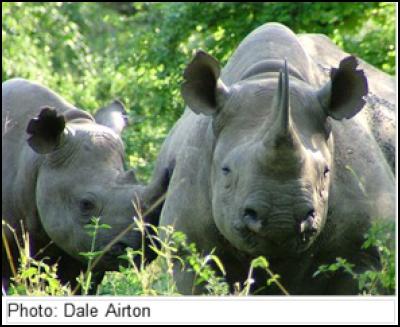First evidence of rhinos’ ability to correct sex imbalance
7 March 2017
First evidence of rhinoceros’ ability to correct gender imbalance

Research led by Victoria University of Wellington has demonstrated the ability of rhinoceros to modify the sex of their offspring to avoid the dominance of one gender and limit severe competition for breeding.
The study, led by Associate Professor Wayne Linklater from Victoria’s School of Biological Sciences, provides the first experimental evidence in the wild that unbalanced population sex ratios can result in a compensatory response by parents to ‘correct’ the imbalance.
“This is called a homeostatic sex allocation (HSA) response—a biological theory first proposed in 1930,” explains Associate Professor Linklater.
“Almost all population models assume birth sex ratio is fixed. Our evidence indicates that this may not be the case.”
The study, published today in Nature Ecology & Evolution, was co-authored by Dr Peter Law from Nelson Mandela Metropolitan University in South Africa, Pierre du Preez from Namibia’s Ministry of Environment and Tourism, and former Victoria University postdoctoral researcher Dr Jay Gedir.
The research team examined 24 years of rhinoceros data, gathered during the course of 45 reintroductions of the animals across southern Africa.
Sex-bias is especially important in rhinoceros populations due to their critically low numbers, says Associate Professor Linklater.
“But because of the evidence of HSA, we need not be so concerned about that misbalance, because parents appear able to ‘correct’ it when they breed.
“HSA has an especially strong effect when the gender imbalance is very large. In fact, the further it is from an even-sex ratio, the stronger the response is by parents.”
Associate Professor Linklater says that those populations where HSA is possible will be more resilient. “Their small populations will have improved establishment and greater viability. Such species will populate habitats faster, and be less susceptible to random demographic processes and genetic drift.”
Explaining the allocation of resources by parents among male and female offspring is a leading issue in evolutionary biology, says Associate Professor Linklater.
“Extreme sex ratios commonly occur, so the incidence of HSA will significantly impact our understanding of a range of ecological processes including invasion biology and conservation management.”
The study was completed with funding from the United States Fish and Wildlife Service’s Rhinoceros and Tiger Conservation Fund.
Associate Professor Linklater now plans to do further research into how an HSA response works in Australian brushtail possums. This includes how competition to breed triggers the effect and at what point in the reproductive process the mother is able to control the sex of her offspring.
“Possums are ideal subjects for such a study because their offspring are born into the marsupial pouch at an extraordinarily young age—very early in development—and so can be studied in great detail,” he says. “Possums are also invasive mammals in New Zealand. Understanding their reproductive processes can provide new ways of managing population numbers.”
ends


 Watercare: Watercare Gets To Work On First Permanent Non-Potable Water Tanker Filling Station In Māngere
Watercare: Watercare Gets To Work On First Permanent Non-Potable Water Tanker Filling Station In Māngere Alcohol Healthwatch: Licensing Decision Lauded For Prohibiting Buy Now Pay Later Schemes In Bottle Stores
Alcohol Healthwatch: Licensing Decision Lauded For Prohibiting Buy Now Pay Later Schemes In Bottle Stores Motor Industry Association: Vehicle Registrations Up 5.6% In December, But Year-To-Date Sales Reflect Market Challenges
Motor Industry Association: Vehicle Registrations Up 5.6% In December, But Year-To-Date Sales Reflect Market Challenges BNZ: Depression-era Bequest Still Helping 88 Years Later
BNZ: Depression-era Bequest Still Helping 88 Years Later Hugh Grant: How Can Telehealth And Home Healthcare Solutions Be Helpful?
Hugh Grant: How Can Telehealth And Home Healthcare Solutions Be Helpful? New Zealand Merino Company: The New Zealand Merino Company Will Investigate PETA Claims
New Zealand Merino Company: The New Zealand Merino Company Will Investigate PETA Claims



